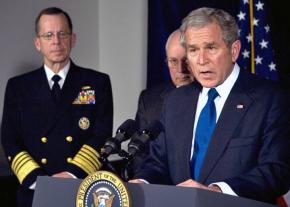The “alternative facts” that led to war on Iraq
Australian socialist shows how the U.S. government and its allies used deliberate misinformation to make the case for war, in an article written for Red Flag.
PRESIDENT TRUMP and his cronies are masters of "alternative facts." But they're not the first. Fifteen years ago, the offices of President George W. Bush, British Prime Minister Tony Blair and Australian Prime Minister John Howard ran a sustained propaganda campaign to justify the pending invasion and subsequent occupation of Iraq. They were assisted by compliant media that reported outright lies as unvarnished fact.
Now, thanks to the release of a highly redacted report written by a senior analyst in the Australian army, it's been confirmed that the case for war was a pack of lies from start to finish.
There were three components of the pro-war propaganda in the months leading up to the attack. One was that Iraq possessed weapons of mass destruction, including chemical weapons, and was ready to use them; it was only a matter of time, furthermore, before Iraq developed a nuclear capability. The second was that Iraqi president Saddam Hussein was funneling assistance to Osama bin Laden's Al Qaeda and other terrorist organizations. The third was that Iraq was flouting UN resolutions.

Originating mainly from the White House and 10 Downing Street, these arguments were eagerly picked up and run by Prime Minister Howard's government, the Murdoch press and large swathes of electronic media.
Even Fairfax's Sydney Morning Herald and Age newspapers, which gave more space to the antiwar case, did their bit. A Herald page-one headline in September 2002 read: "Saddam ready and able to strike. British PM claims Iraq could launch weapons of mass destruction in 45 minutes."
Despite this sustained propaganda offensive, most people were never won to the case for war. In January 2003, only 6 percent of Australians supported joining the invasion without UN backing. More impressive were the enormous antiwar rallies over the weekend of February 14-15, 2003, with 800,000 Australians turning out against the looming invasion, along with millions more in the rest of the world.
"No war for oil!" was our chant. For some, this meant that the war was solely about the U.S. stealing Iraq's oil and handing out "reconstruction" contracts to well-connected firms like Halliburton. Socialists argued that there was more to it than just outright theft; the attack on Iraq was driven by the United States' attempt to reinforce its hegemony not just in the Middle East but around the world.
By controlling the supply of oil from Iraq, one of the world's largest producers, the U.S. could gain leverage over established imperialist rivals in Europe as well as up-and-coming powers such as China, whose economies depended on Middle Eastern oil. It was about the U.S. using the one tool, military firepower, in which it had a distinct advantage over all its rivals, to show who was boss.
WE DIDN'T stop the war. The result was perhaps even worse than we had anticipated. The attack on Iraq destroyed the lives of millions of people and fostered the regional chaos that has resulted in the growth of ISIS and the spread of sectarian warfare. And now, 14 years later, U.S., British and Australian armed forces are back in Iraq, while the occupation of Afghanistan grinds on.
But if we couldn't stop the war, our case against it has been proven in spades. It was a war justified by lies. No weapons of mass destruction were ever found. No links with bin Laden were ever established. Hussein posed no threat to any of his neighbors, as U.S.-sponsored UN resolutions pretended. This has now been confirmed by countless inquiries, most recently the Chilcot Inquiry in Britain.
The recent release to the Fairfax press of a 572-page report by the Defence Directorate of Army Research and Analysis, written in 2011 and based on dozens of interviews with senior personnel in the military and with the benefit of full access to confidential documents, drives another nail into the coffin of the war propagandists. The author, Dr. Albert Palazzo, writes that the stated rationale for the war was nothing more than "mandatory rhetoric."
According to Palazzo, the main reason that Australia joined the U.S.'s "coalition of the willing" was to remind the U.S. of its value as a partner.
Palazzo argues that Australia's military contribution to the conduct of the war was negligible, a conscious decision by the Howard government and chief of the defense force, general Peter Cosgrove, who were acutely sensitive to the political unpopularity of Australia's involvement and anxious to minimize Australian casualties.
From the government's perspective, the deployment of Special Air Service Regiment and commandos, navy and air force was a political gesture aimed at reinforcing the U.S. alliance. Any military contribution these could make, Palazzo wrote, was "secondary to the vital requirement of just being there."
This report confirms that, far from the U.S. alliance "protecting Australia," it is the basis for Australia's involvement alongside the U.S. in bloody military conflicts all around the world. The main purpose of these interventions, invasions and occupations is to reinforce the power of the U.S. and its junior partners, both in the regions directly affected and on a world scale. The interests of Australian and U.S. civilians are irrelevant when the decision is taken to go to war.
But that fundamental truth can never be openly admitted. It must be covered up by a mountain of lies and obfuscation. That is the only way the system can work, based as it is on the rule of a tiny minority, the capitalist class, over the large majority, the working class.
First published at Red Flag.


